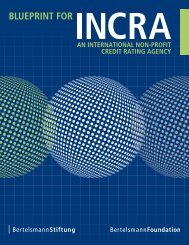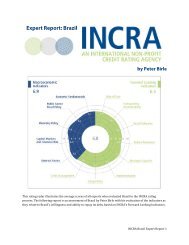But China’s competitive meridian withEurope is slowly moving northward.Whereas for most of the past decade,China’s direct competition was withthe light industry of the south (textilesin Italy and Greece), movement intoautomobiles, brand developmentin computers and machinery, andgreen technology posit China directlyagainst Germany. In some ways, this issimilar to the movement of US-Chinamanufacturing competition from lightindustry to heavy industry and services.This trend is expected to continue.European engagementin China has two keycharacteristics: it ispredominantly driven bybilateral relations withindividual member states,and it is overwhelminglyeconomic in nature.France, which was the driver of theSino-European relationship at itszenith, has somewhat lost its footingwith China in recent years, beginningwith the diplomatic battle in 2008 overPresident Nicolas Sarkozy’s willingnessto informally meet with the Dalai Lama,which led to the cancellation of theEU-China Summit. This continued withSarkozy’s high-profile and unsuccessfulattempt to galvanize Chinese financialsupport for EFSF bonds in fall 2011. SinceFrance’s most recent elections, relationswith China have largely remained static.François Hollande’s government has yetto articulate a strategic relationship,a fact that perplexes senior Europeanofficials, particularly from Germany.The US pivot to Asia rates high on theagenda of European policymakers. Thereis concern among some Europeansthat they will be neglected as the USshifts focus. The small and mediumsizedCentral and Eastern Europeancountries, whose exposure to potentialsecurity risks from Russia is moreimmediate, are more alarmed by therealigned emphasis on Asia and willrequire the greatest assurance fromWashington. Yet these governmentsrealize the budget constraints on the USmilitary and, unwilling to increase theirown defense budgets, recognize that toomuch pressure on Washington will beunseemly and unlikely to change policy. 6There are others that welcome greaterUS engagement in the Asia Pacific. It isin Europe’s, and particularly Germany’s,interest that the strategic pivot to Asiago ahead. As Europe’s largest tradepartner with Asia, Germany can free-rideon US military presence in the region tostabilize sea trade routes and other globalcommons. The British share this viewand expect to be the quiet beneficiariesof US force posture readjustment. Thatsaid, the UK, Germany and the EuropeanCommission are more ambivalentabout the potential consequences ofthe Asia pivot’s economic aspects. TheEuropeans are aware however that theUS expects them to play a bigger rolein their immediate neighborhood as aresult of the pivot.The EU retains a grander vision forits China relationship. 57 percent ofEuropean foreign policy elites arenot satisfied with the EU’s role in theAsia Pacific, and 96 percent believe itshould be doing more. 7 Accordingly it isbeginning to play catch-up to memberstates on China and the Asia Pacificregion more broadly. The publicationof the June 2012 Guidelines on the EU’sForeign and Security Policy in East Asiaand recent high-profile dialogues onsecurity and economic issues indicatesan expansion of thought on the topic. 8But there is no policy area today inwhich Europe and China see each otheras main strategic partners. Negotiationson a Partnership and CooperationAgreement (PCA), to codify a newstrategic relationship between the EUand China, have slowed to a standstillsince 2007. The European ExternalAction Service (EEAS) still sees Chinaas one of six global strategic partners,as was identified in the 2003 EuropeanSecurity Strategy (ESS). But it has notreleased an updated communicationon China in six years, a conspicuousindication that Brussels’ China policy,once seen as promising, remainssomewhat underdeveloped.Recommendations for 2013The US and Europe have numerousareas in which cooperation on Chinaand the Asia-Pacific more broadly areripe for development in 2013. Theseare primarily in, but not limited to, theeconomic sphere, based on the manyareas where economic and strategicthinking intersect. The US must maintaina modular approach to Europe in itsapproach to cooperation on China. Boththe EU and individual member states,at varying levels, have unique assetsand political considerations that canadvance US interests in the region.1. Aim for policy alignment atall levels on regional strategicgeopolitical issues:Europe will not represent a traditionalsecurity power in its own right in EastAsia. Limited expeditionary capabilitiesand bases, weak security alliancenetworks and anemic domestic politicalinterest are among the reasons thatEuropeans will have a lesser role inmajor security questions. As such,Europe remains a limited player insecurity on the Pacific Rim and has notshown aspirations to change this.However, the US and EU can worktogether for strategic clarity on jointinterests in the region. The joint US-EU ASEAN Regional Forum statementis a positive start. In it, both powerssupported multilateral moves to resolvelongstanding territorial disputes. Thiswas a turning point, representing awillingness to forge common positions.But it was countered in numeroussubsequent communiqués, includingthe Sino-German communiqué in Beijing(August 2012) and the EU-China SummitCommuniqué in Brussels (September2012), which, in territorial disputes werenot mentioned. 9 Still, the EU has openlyrecognized the importance of regionalsecurity architecture and the key US rolein it. 10 The EU has expressed interest inacceding to ASEAN’s Treaty of Amnityand Cooperation (TAC) and enhancedcooperation in the Asia-Europe Meeting(ASEM) process. Greater politicalrepresentation in the regional securityarchitecture, while modest, should be7 2China
welcomed. But true credibility will comethrough consistency at all levels. Twoareas in particular are key to moving thiscooperation forward:a) Consult on developments in the trans-Atlantic defense industry in Asia: Longseen as the cornerstone of the US-EUdialogue on China, the EU weaponsembargo seems likely to remain in placefor the next four years. The most stalwartopponents to lifting the embargo againstChina—the Scandinavian members ofthe EU and the post-Lisbon EuropeanParliament—have gained strength since2005, and given the appreciation of theenhanced security role of the US in theAsia Pacific, a lifting of the embargo ishighly unlikely without marked politicalchanges in Beijing.But the embargo’s points have beenwhittled away in the two decades sinceit was imposed, and implementation atthe national level has led to a narrowinterpretation of its applicability.European states have a key interest inthe growing defense market that a risingAsia, and particularly China, represents.As a result of the financial downturn,European states have pushed throughsignificant cuts in domestic defensespending (8 percent in both Germany andthe UK). 11 Many European States havea substantial and globally competitivedefense industrial base, with blue-chipcompanies in France, Italy and the UK anda strong base of specialized Mittelstanddefense companies in Germany (whichsurpassed France and the UK over thelast decade to become the country withEurope’s largest defense sector). Starvedfor domestic sales, these companiesand their home states’ governments willmore aggressively seek foreign markets.Given these trends and the growing USsecurity role in the Asia Pacific, it will beimportant for both the US and Europe toconsult regularly on the potential impactof defense procurement contracts onthe region’s threat assessment. Thepartners should also look at how theircooperation will affect rising defenseand dual-technology industries such asspace and cybersecurity technology [seepage 44].b) Pursue greater complementarity inthe Asian periphery: The EU and itsconstituent states have greater leverageand are able to act with greater resolveand unity in the high-growth smallstates of Southeast Asia. The EU ispursuing bilateral FTAs with Singaporeand Malaysia, negotiating a widerangingFramework Agreement with NewZealand, and exploring ambitious tradeagreements with ASEAN, India andJapan. The EU has also been involvedin conflict resolution and post-conflictreconstruction programs in Aceh,Indonesia; East Timor; and Mindanaoin the Philippines, while undertakingdevelopment efforts on water rightsand usage along the Mekong River inCambodia. The EU, along with Australiaand New Zealand, is a significantdevelopment donor to Pacific islandstates. A strong ground game in thesmall and medium states on the PacificRim is perhaps the greatest asset to atandem approach to Asia. The US andEurope should harmonize developmentefforts on political system reform,capacity building, judiciary reform, ruleof law and media. They should alsowork together on people-to-peopleexchanges, particularly relating tobusiness and law.A tandem strategy—pursuing TPP and atrans-Atlantic compactsimultaneously—isambitious but couldproduce the bestbargaining position forthe US with [Europe andthe Asia Pacific].2. Work on an intra-Atlanticreaffirmation of globaleconomic governance:While most of Europe’s largesteconomies are sanguine about themilitary aspect of the US pivot to Asia,some leaders, particularly in Germanyand the European Commission, areconcerned that the TPP will drain all ofthe US administration’s political capitalfor market liberalization, leaving littleleft for a similarly ambitious economiccompact with the EU. They fear thatthis could 1) leave the US and Europeuntethered as they engage Asia or 2) pitthem against each other as competitorsin the region. As a result, both the US andEurope would be in a weaker negotiatingposition in the Asia Pacific.A tandem strategy—pursuing TPP and atrans-Atlantic compact simultaneously—is ambitious but could produce the bestbargaining position for the US with bothregions. As counterintuitive as it maysound, one of the most effective jointAsia strategies would be for the US andEurope to commit fully to talks witheach other. The implicit effect of a trans-Atlantic compact [discussed at lengthon p. 11] will be a recommitment to therules-based liberal order that has beenthe basis for US and European economicsuccess. This commitment could have asignaling effect to China and other majoremerging economies in the region. Suchdiscussions should fall along two lines:a) Initiate a frank, depoliticized discussionabout investment and procurementmarkets: The US and Europe shouldwork together informally to createcoordinated norms in their economicinteraction with China. Some of themost dynamic and fruitful exchangesbetween the US and EU in recent yearshave been on this topic, and they haveyielded positive results on joint policyalternatives for exploration, recyclingand substitution of rare earth mineralsand concerns around intellectualproperty rights (IPR), particularly in theIT sector. Two areas ripe for intensifiedUS-EU consultation are investmentand procurement policy. Chinese FDIrepresents an opportunity for whichboth the US and EU should prepare.Despite representing a low stock in theUS and EU (approximately 0.2 percentof total FDI), Chinese investment powerin the coming years will reach a degreematching its status as a trade powertoday. 12First, the US should closely monitor EU-China Bilateral Investment Treaty (BIT)China7 3
- Page 3:
Field Manual to EuropeIntroduction
- Page 6:
multilateral channels. Europeanshav
- Page 9 and 10:
JuneBritish presidency of UNSCJune
- Page 12 and 13:
US-EU Investment vs. Global Nationa
- Page 14 and 15:
economic conditions in the eurozone
- Page 17 and 18:
MEMO ONTHE EUROZONE CRISISThe State
- Page 19 and 20:
attitude toward moral hazard. Withw
- Page 21 and 22: Greece: 2010 Bailout BreakdownGreec
- Page 23 and 24: the deficit from 4.5 percent to thr
- Page 27 and 28: NATO thus faces an uncertain future
- Page 29 and 30: 1. Consider NATO’s defensespendin
- Page 31 and 32: of-area operations and worldwidepar
- Page 33 and 34: concurrent terrorist attack in Beng
- Page 35: 2. Strengthen regionalpartnerships
- Page 38 and 39: MEMO ONCOUNTERTERRORISM ANDHOMELAND
- Page 40 and 41: home affairs (JHA), particularly in
- Page 43 and 44: Status of EU Countries in the US Vi
- Page 45 and 46: offensive capability centered at NA
- Page 47 and 48: socialized, i.e. there is a tacit e
- Page 49 and 50: such technology, such as deep packe
- Page 51 and 52: MEMO ONENERGY & CLIMATE CHANGEThe S
- Page 54 and 55: identifying the agents most qualifi
- Page 56 and 57: MEMO ONTURKEYThe State of PlayTurke
- Page 58 and 59: as a rising regional and internatio
- Page 60 and 61: CASE STUDY: TURKEY’S ENERGY ROLE:
- Page 62 and 63: 22%12%Turkey’s Main Trading Partn
- Page 64 and 65: MEMO ONRUSSIAThe State of PlayIn Pr
- Page 66 and 67: EU-Russia security apparatus. Themo
- Page 68 and 69: greater market access for US busine
- Page 70 and 71: MEMO ONCHINAThe State of PlayIn 201
- Page 74 and 75: in millions of USDUS-China Bilatera
- Page 76 and 77: 7 6Acknowledgements
- Page 78 and 79: CITATIONSINTRODUCTION1See “Confid
- Page 80 and 81: 20Castle, S. (17 September, 2011).
- Page 82 and 83: ARAB UPRISING1Koch, C. (summer 2011
- Page 84 and 85: COUNTERTERRORISM & HOMELAND SECURIT
- Page 86 and 87: 21Healey, J. (January 2012). Beyond
- Page 88 and 89: 20Berlemont, I. (25 July, 2012). Fr
- Page 90 and 91: 24Putin, V. (6 September, 2012). An
- Page 92: Bertelsmann Foundation1101 New York






